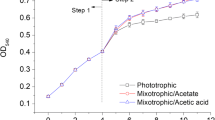Abstract
A fed-batch culture process followed by subsequent photoautotrophic induction was established for the high density culture of astaxanthin-rich Haematococcus pluvialis using a CO2-fed flat type photobioreactor under unsynchronized illumination. Fed-batch culture was performed with an exponential feeding strategy of the growth-limiting nutrients, nitrate and phosphate, concurrently with the stepwise supplementation of light depending on the cell concentration. During the growth phase, a biomass of 1.47 g/L was obtained at a biomass productivity of 0.33 g/L/day. Photoautotrophic induction of the well-grown vegetative cells was performed consecutively by increasing the light intensity to 400 μmol photon/m2/s, while keeping the other conditions in the CO2-fed flat type photobioreactor fixed, yielding an astaxanthin production of 190 mg/L at an astaxanthin productivity of 14 mg/L/day. The proposed sequential photoautotrophic process has high potential as simple and productive process for the production of valuable Haematococcus astaxanthin.




Similar content being viewed by others
References
Guerin M, Huntley ME, Olaizola M (2003) Haematococcus astaxanthin; applications for human health and nutrition. Trends Biotechnol 21:210–216
Kobayashi M, Sakamoto Y (1999) Singlet oxygen quenching ability of astaxanthin esters from the green alga Haematococcus pluvialis. Biotechnol Lett 21:265–269
Margalith PZ (1999) Production of ketocarotenoids by microalgae. Appl Microbiol Biotechnol 51:431–438
Olaizola M (2003) Commercial development of microalgal biotechnology: from the test tube to the marketplace. Biomol Eng 20:459–466
Kakizono T, Kobayashi M, Nagai S (1992) Effect of carbon/nitrogen ratio on encystment accompanied with astaxanthin formation in a green alga, Haematococcus pluvialis. J Ferment Bioeng 74:403–405
Kobayashi M, Kakizono T, Nagai S (1991) Astaxanthin production by a green alga, Haematococcus pluvialis accompanied with morphological changes in acetate media. J Ferment Bioeng 71:335–339
Kobayashi M, Kakizono T, Nagai S (1993) Enhanced carotenoids biosynthesis by oxidative stress in acetate induced cyst cells of a green unicellular alga, Haematococcus pluvialis. Appl Environ Microbiol 59:867–873
Orosa M, Franqueira D, Cid A, Abalde J (2001) Carotenoid accumulation in Haematococcus pluvialis in mixotrophic growth. Biotechnol Lett 23:373–378
Orosa M, Franqueira D, Cid A, Abalde J (2005) Analysis and enhancement of astaxanthin accumulation in Haematococcus pluvialis. Bioresour Technol 96:373–378
Domínguez-Bocanegra AR, Legarreta IG, Jeronimo FM, Campocosio AT (2004) Influence of environmental and nutritional factors in the production of astaxanthin from Haematococcus pluvialis. Bioresour Technol 92:209–214
Fábregas J, Domínguez A, Maseda A, Otero A (2003) Interactions between irradiance and nutrient availability during astaxanthin accumulation and degradation in Haematococcus pluvialis. Appl Microbiol Biotechnol 61:545–551
Fábregas J, Otero A, Maseda A, Domínguez A (2001) Two stage cultures for the production of astaxanthin from Haematococcus pluvialis. J Biotechnol 89:65–71
Harker M, Tsavalos AJ, Young AJ (1996) Factors responsible for astaxanthin formation in the chlorophyte Haematococcus pluvialis. Bioresour Technol 55:207–214
Hata N, Ogbonna JC, Hasegawa Y, Taroda H, Tanaka H (2001) Production of astaxanthin by Haematococcus pluvialis in a sequential heterotrophic-photoautotrophic culture. J Appl Phycol 13:395–402
Sarada R, Tripathi U, Ravishankar GA (2002) Influence of stress on astaxanthin production in Haematococcus pluvialis grown under different culture conditions. Process Biochem 37:623–627
Aflalo C, Meshulam Y, Zarka A, Boussiba S (2007) On the relative efficiency of two- vs. one-stage production of astaxanthin by the green alga Haematococcus pluvialis. Biotechnol Bioeng 98:300–305
Choi SL, Suh IS, Lee CG (2003) Lumostatic operation of bubble column photobioreactors for Haematococcus pluvialis cultures using a specific light uptake rate as a control parameter. Enzyme Microb Technol 33:403–409
García-Malea MC, Acién FG, Fernández JM, Cerón MC, Molina E (2006) Continuous production of green cells of Haematococcus pluvialis: modeling of the irradiance effect. Enzyme Microb Technol 38:981–989
Kaewpintong K, Shotipruk A, Powtongsook S, Pavasant P (2007) Photoautotrophic high-density cultivation of vegetative cells of Haematococcus pluvialis in airlift bioreactor. Bioresour Technol 98:288–295
Suh IS, Joo HN, Lee CG (2006) A novel double-layered photobioreactor for simultaneous Haematococcus pluvialis cell growth and astaxanthin accumulation. J Biotechnol 125:540–546
Kang CD, Lee JS, Park TH, Sim SJ (2005) Comparison of heterotrophic and photoautotrophic induction on astaxanthin production by Haematococcus pluvialis. Appl Microbiol Biotechnol 68:237–241
Kang CD, Lee JS, Park TH, Sim SJ (2007) Complementary limiting factors of astaxanthin synthesis during photoautotrophic induction of Haematococcus pluvialis: C/N ratio and light intensity. Appl Microbiol Biotechnol 74:987–994
Lee J, Lee SY, Park S, Middelberg APJ (1999) Control of fed-batch fermentations. Biotechnol Adv 17:29–48
Yuan JP, Chen F (1998) Chromatographic separation and purification of trans-astaxanthin from the extracts of Haematococcus pluvialis. J Agric Food Chem 46:3371–3375
Yuan JP, Chen F (2000) Purification of trans-astaxanthin from a high-yielding astaxanthin ester-producing strain of the microalga Haematococcus pluvialis. Food Chem 68:443–448
Lee HS, Seo MW, Kim ZH, Lee CG (2006) Determining the best specific light uptake rates for the lumostatic cultures in bubble column photobioreactors. Enzyme Microb Technol 39:447–452
Lee HS, Kim ZH, Jung SE, Kim JD, Lee CG (2006) Specific light uptake rate can be served as a scale up parameter in photobioreactor operations. J Microbiol Biotechnol 16:1890–1896
Acknowledgment
This research was supported by a grant (DG2-201) from Carbon Dioxide Reduction & Sequestration Research Center, one of the Twenty-first Century Frontier Programs funded by the Ministry of Science and Technology of Korean government.
Author information
Authors and Affiliations
Corresponding author
Rights and permissions
About this article
Cite this article
Kang, C.D., Han, S.J., Choi, S.P. et al. Fed-batch culture of astaxanthin-rich Haematococcus pluvialis by exponential nutrient feeding and stepwise light supplementation. Bioprocess Biosyst Eng 33, 133–139 (2010). https://doi.org/10.1007/s00449-009-0362-5
Received:
Accepted:
Published:
Issue Date:
DOI: https://doi.org/10.1007/s00449-009-0362-5




